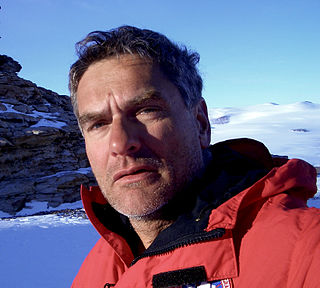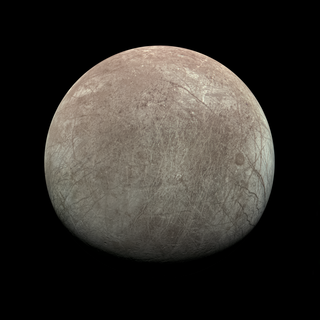
Astrobiology is a scientific field within the life and environmental sciences that studies the origins, early evolution, distribution, and future of life in the universe by investigating its deterministic conditions and contingent events. As a discipline, astrobiology is founded on the premise that life may exist beyond Earth.

Hypothetical types of biochemistry are forms of biochemistry agreed to be scientifically viable but not proven to exist at this time. The kinds of living organisms currently known on Earth all use carbon compounds for basic structural and metabolic functions, water as a solvent, and DNA or RNA to define and control their form. If life exists on other planets or moons it may be chemically similar, though it is also possible that there are organisms with quite different chemistries – for instance, involving other classes of carbon compounds, compounds of another element, or another solvent in place of water.

The possibility of life on Mars is a subject of interest in astrobiology due to the planet's proximity and similarities to Earth. To date, no proof of past or present life has been found on Mars. Cumulative evidence suggests that during the ancient Noachian time period, the surface environment of Mars had liquid water and may have been habitable for microorganisms, but habitable conditions do not necessarily indicate life.

Argyre Planitia is a plain located within the impact basin Argyre in the southern highlands of Mars. Its name comes from a map produced by Giovanni Schiaparelli in 1877; it refers to Argyre, a mythical island of silver in Greek mythology.
A biosignature is any substance – such as an element, isotope, molecule, or phenomenon – that provides scientific evidence of past or present life on a planet. Measurable attributes of life include its complex physical or chemical structures, its use of free energy, and the production of biomass and wastes.

The hydrogen cycle consists of hydrogen exchanges between biotic (living) and abiotic (non-living) sources and sinks of hydrogen-containing compounds.

Dr Christopher P. McKay is an American planetary scientist at NASA Ames Research Center, studying planetary atmospheres, astrobiology, and terraforming. McKay majored in physics at Florida Atlantic University, where he also studied mechanical engineering, graduating in 1975, and received his PhD in astrogeophysics from the University of Colorado in 1982.
Thermosynthesis is a theoretical mechanism proposed by Anthonie Muller for biological use of the free energy in a temperature gradient to drive energetically uphill anabolic reactions. It makes use of this thermal gradient, or the dissipative structure of convection in this gradient, to drive a microscopic heat engine that performs condensation reactions. Thus negative entropy is generated. The components of the biological thermosynthesis machinery concern progenitors of today's ATP synthase, which functions according to the binding change mechanism, driven by chemiosmosis. Resembling primitive free energy generating physico-chemical processes based on temperature-dependent adsorption to inorganic materials such as clay, this simple type of energy conversion is proposed to have sustained the origin of life, including the emergence of the RNA World. For this RNA World it gives a model that describes the stepwise acquisition of the set of transfer RNAs that sustains the Genetic code. The phylogenetic tree of extant transfer RNAs is consistent with the idea.

The habitability of natural satellites is the potential of moons to provide habitats for life, though it is not an indicator that they harbor it. Natural satellites are expected to outnumber planets by a large margin and the study of their habitability is therefore important to astrobiology and the search for extraterrestrial life. There are, nevertheless, significant environmental variables specific to moons.

EXPOSE is a multi-user facility mounted outside the International Space Station (ISS) dedicated to astrobiology. EXPOSE was developed by the European Space Agency (ESA) for long-term spaceflights and was designed to allow exposure of chemical and biological samples to outer space while recording data during exposure.

The possibility of life on Venus is a subject of interest in astrobiology due to Venus' proximity and similarities to Earth. To date, no definitive evidence has been found of past or present life there. In the early 1960s, studies conducted via spacecraft demonstrated that the current Venusian environment is extreme compared to Earth's. Studies continue to question whether life could have existed on the planet's surface before a runaway greenhouse effect took hold, and whether a relict biosphere could persist high in the modern Venusian atmosphere.
Interplanetary contamination refers to biological contamination of a planetary body by a space probe or spacecraft, either deliberate or unintentional.

The Earth Similarity Index (ESI) is a proposed characterization of how similar a planetary-mass object or natural satellite is to Earth. It was designed to be a scale from zero to one, with Earth having a value of one; this is meant to simplify planet comparisons from large databases.
The Biological Oxidant and Life Detection (BOLD) is a concept mission to Mars focused on searching for evidence or biosignatures of microscopic life on Mars. The BOLD mission objective would be to quantify the amount of hydrogen peroxide existing in the Martian soil and to test for processes typically associated with life. Six landing packages are projected to impact 'softly' on Mars that include a limited power supply, a set of oxidant and life detection experiments, and a transmitter, which is able to transmit information via an existing Mars orbiter back to Earth. The mission was first proposed in 2012.

Icebreaker Life is a Mars lander mission concept proposed to NASA's Discovery Program. The mission involves a stationary lander that would be a near copy of the successful 2008 Phoenix and InSight spacecraft, but would carry an astrobiology scientific payload, including a drill to sample ice-cemented ground in the northern plains to conduct a search for biosignatures of current or past life on Mars.
The Virtual Planetary Laboratory (VPL) is a virtual institute based at the University of Washington that studies how to detect exoplanetary habitability and their potential biosignatures. First formed in 2001, the VPL is part of the NASA Astrobiology Institute (NAI) and connects more than fifty researchers at twenty institutions together in an interdisciplinary effort. VPL is also part of the Nexus for Exoplanet System Science (NExSS) network, with principal investigator Victoria Meadows leading the NExSS VPL team.
Signs Of LIfe Detector (SOLID) is an analytical instrument under development to detect extraterrestrial life in the form of organic biosignatures obtained from a core drill during planetary exploration.
Professor Abel Méndez is a planetary astrobiologist and Director, at the University of Puerto Rico at Arecibo. His research focuses on the habitability of potentially habitable exoplanets. Méndez is also a NASA MIRS Fellow with research experience at NASA, and the Arecibo Observatory.










